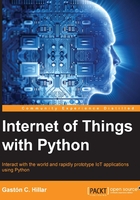
Chapter 1. Understanding and Setting up the Base IoT Hardware
In this chapter, we will start our journey towards Internet of Things (IoT) with Python and the Intel Galileo Gen 2 board. Python is one of the most popular and versatile programming languages. You can use Python to create multiplatform desktops and Web, mobile, and scientific applications. You can work with huge amounts of data and develop the complex algorithms that are popular in Big Data scenarios with Python. There are thousands of Python packages, which allow you to extend Python capabilities to any kind of domain you can imagine.
We can leverage our existing knowledge of Python and all of its packages to code the different pieces of our IoT ecosystem. We can use the object-oriented features, which we love from Python. in code that interacts with the Intel Galileo Gen 2 board and the electronic components connected to it. We can use the different packages that make it possible for us to easily run a Web server and provide a RESTful API. We can use all the packages that we already know to interact with databases, Web services, and different APIs. Python makes it easy for us to jump into the IoT world. We don't need to learn another programming language, we can use the one we already know and love.
First, we will learn about the features included in the Intel Galileo Gen 2 board. We will:
- Understand the Intel Galileo Gen 2 board and its components
- Recognize the Input/Output and the Arduino 1.0 pinout
- Learn about the additional expansion and connectivity capabilities
- Understand the buttons and the LEDs found in the board
- Check and upgrade the board's firmware